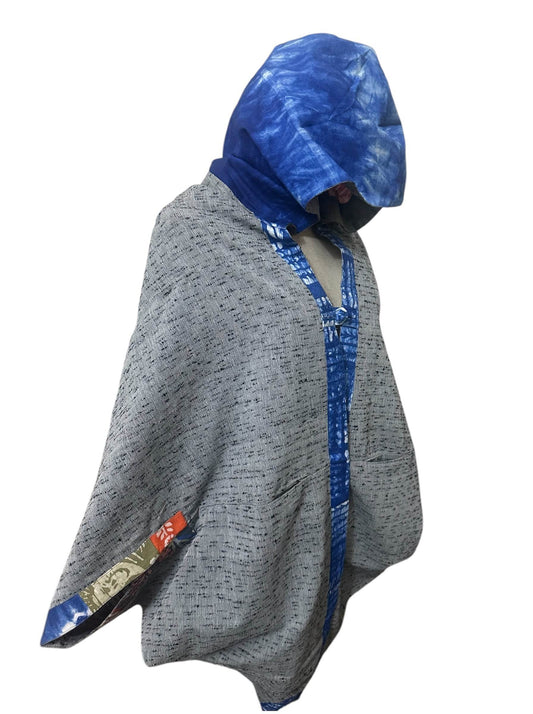House of SHUI: A Legacy in Every Stitch

Quiet confidence, refined design — inside Zawaad Wasee’s vision.
In an age of algorithms and drop culture, House of SHUI moves at a different pace. It doesn't shout. It doesn't chase trends. Instead, it holds its ground—quietly, confidently—and invites you to come closer.
Co-Founded by Zawaad Wasee, House of SHUI is more than a clothing label. It’s a reflection of slow intention, design integrity, and cultural pride. “From a very young age, I knew I wanted to build something of my own,” he says. “The dream was always there—vivid, but undefined.” Fashion wasn’t the original goal, but once it found him, it made sense. "Style tells stories without words. It speaks before you do. That power—it drew me in."
What began as an instinct turned into a calling. Textures, cuts, silhouettes — these details began to matter more. With time, Zawaad’s focus shifted from inspiration to purpose. He no longer saw clothing as a product. He saw it as permanence. “I became more conscious of how much craftsmanship matters. Over time, it became clear: this was the space I wanted to carve my path in.”
That path would take shape as House of SHUI — a label grounded in authenticity, quiet luxury, and cultural pride. The brand doesn’t follow seasonal noise. Instead, it draws from heritage and emotion, aiming to create garments that feel lived-in from the moment you put them on.
Zawaad’s creative compass was guided in part by the legacy of Ralph Lauren — not just the clothing, but the world he built around it. “His work speaks of legacy. Garments made to outlive seasons. Pieces made to be passed on.”
House of SHUI isn’t just a brand. It’s a body of work. A reflection of selfhood, discipline, inspiration, and emotion. It’s a slow burn — the kind that stays with you. “It’s my ode to heritage, self-expression, and the pursuit of quality”.
The Needle
The name SHUI comes from the Bengali word for needle. “A tool so small, yet so essential,” Zawaad explains. “It represents precision, craftsmanship, and quiet strength.” That symbolism became the brand’s foundation: intentional, detailed, and deeply rooted.
SHUI today has two distinct voices.
SHUI di Artigiani — meaning “Needle of Artisans” in a blend of Bengali and Italian — offers refined classic menswear. It speaks to those who value refinement and longevity in style.
SHUI Ethnic embraces Bangladeshi heritage, reworking traditional silhouettes with contemporary relevance.
Together, the two labels speak to SHUI’s dual mission: to elevate local artistry and present it on a global stage, without losing its cultural spine.

Timelessness as Resistance
In a world obsessed with what’s next, SHUI is obsessed with what lasts. “We’re not here to do 100 designs a year. We’re here to make one great piece that someone might still wear a decade from now,” says Zawaad.
Sustainability at SHUI isn’t branding fluff—it’s embedded in the design process. “True sustainability begins with longevity,” he says. “It’s about creating garments that don’t need replacing. Pieces you grow into, and grow with.”
That means durable materials, ethical sourcing, and craftsmanship that respects both people and planet. “We’re constantly learning. We’re not perfect, but we’re intentional.”
Personal Style, Collective Vision
Zawaad’s own style is much like the brand’s DNA—rooted in simplicity, executed with sharpness. If he had to choose one color to embody the House, it would be navy. “It speaks of timelessness, depth, and quiet confidence,” he says. “Navy is elegance without trying.”
His admiration for designers like Ralph Lauren says a lot about SHUI’s ambitions. “Ralph didn’t just create clothes—he created a world. That’s what inspires me. Legacy pieces. Clothing that outlives moments.”
You can feel that influence in SHUI’s commitment to storytelling. Every collection isn’t just a lookbook—it’s a perspective.

Building the House
The journey from vision to reality wasn’t rushed. “It took years of learning, observing, and patiently waiting for the right time,” Zawaad says. “When it finally arrived, I knew I wanted to offer more than just clothing. I wanted to offer an experience.”
House of SHUI is that experience—designed for people who value the process behind the product. For those who want their wardrobe to feel personal, not performative.
“My creative process is… weird,” he laughs. “A bit of chaos, some intuition, and late-night ideas that either become collections—or stay in my sketchbook forever.”
What drives him isn’t perfection. It’s persistence. “As Churchill said, ‘If you’re going through hell, keep going.’ I’ve held onto that.”

Arka: Platform and Catalyst
Zawaad credits Arka Collective as a key moment in SHUI’s story. “It’s brought more eyes to the brand, opened doors to collaborations, and helped us connect with the kind of audience that values design and storytelling,” he says.
More than visibility, Arka gave SHUI context. “It’s a creative sanctuary,” he reflects. “Not just a platform, but a curated experience. A space where art, culture, and individuality come together.”
The alignment was natural. “Like Arka, SHUI is about intention, authenticity, and heritage—reimagined.”
Looking Ahead: SHUI in Five Years
When asked about the future, Zawaad is clear without being rigid. “I’d love for SHUI to be a household name in Bangladesh—known for quality, not quantity,” he says. “I dream of having our own physical store. A place where people can walk in, feel the fabric, and see the story behind every stitch.”
His vision is less about global domination, more about meaningful presence. “We want SHUI to be part of people’s lives. A symbol of pride. A reflection of thoughtful, intentional fashion.”
If he could reimagine SHUI in another decade? The 1950s. “That era captured everything I love: refined craftsmanship, tailored silhouettes, and enduring style. It was about quality over quantity—exactly what we stand for.”
The House as Home
At its core, House of SHUI is personal. It’s as much about identity as it is about clothing. “It’s my ode to heritage, self-expression, and the pursuit of quality,” Zawaad says. “It’s not just meant to be worn—it’s meant to be lived in.”
The House is still growing. But its foundation is strong. And it’s being built with care.



